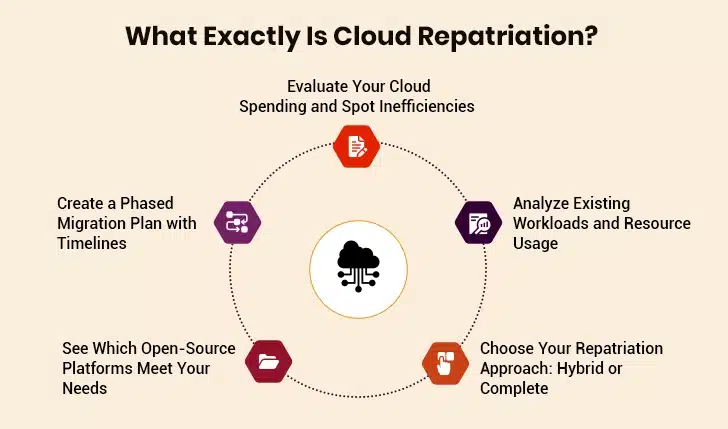Cloud costs have reached unmanageable levels. This reality is forcing a major shift. A majority of companies plan to bring workloads back from public clouds, a move called repatriation. Why? Because controlling cloud spending has become a challenge.
A significant amount gets wasted on underused resources and hidden fees. These financial drains push businesses to rethink their cloud strategies. Major players have already made substantial savings by moving key systems back.
Repatriation means shifting applications or data from public clouds to private infrastructure. It is rarely about abandoning the cloud entirely. Instead, most companies adopt hybrid approaches, balancing cloud and on-premises solutions. Public cloud use still grows, but smarter consolidation is rising.
This blog explores whether the surge in cloud repatriation signals cost chaos or smart consolidation. We learn about scenarios where moving workloads back makes financial sense and where it doesn’t. Let’s get started.
Table of Contents
What Exactly Is Cloud Repatriation?
Why Are Costs Spiraling in the Public Cloud?
When Does Repatriation Deliver Real ROI?
What Hidden Costs Lurk in Repatriation?
How Does AI Accelerate Repatriation?
What Is the Smart Consolidation Strategy?
What Exactly Is Cloud Repatriation?
Cloud repatriation is a calculated retreat from public cloud environments. Companies pull back from the cloud for several reasons, but costs usually drive this decision.
Cloud repatriation cannot be called an all-or-nothing choice. It works more like a spectrum. Organizations take one of these three paths:
- Complete Repatriation: Moving all workloads and data from the public cloud back to their own on-premises infrastructure.
- Hybrid Repatriation: Moving specific workloads back while keeping others in the cloud to create a balanced hybrid setup.
- Provider Shifting: Switching workloads between different cloud providers or from large providers to local ones.
Companies typically get a full picture of their workload patterns, performance needs, and finances before deciding to move back. Workloads that have steady, predictable resource needs make strong candidates for repatriation. These don’t benefit from the expensive elastic scaling that cloud environments offer. Data analytics platforms that handle sensitive information are also brought back on-premises quite often.
Ultimately, successful repatriation requires careful planning, detailed cost analysis, and a proper evaluation of internal capabilities. Companies must know if they have the right expertise to manage on-premises infrastructure before they start this journey back home.
Why Are Costs Spiraling in the Public Cloud?
Cloud bills are getting out of hand. Most companies consider managing their cloud spend a major challenge. Cloud budgets already exceed limits by 17%, pushing businesses to think about repatriation as an alternative. The issue runs deeper than most companies realize.
1. Cloud Waste
Businesses lose a large portion of their cloud expenses to inefficiencies. About 21% of enterprise cloud infrastructure spending goes to waste on underutilized resources.
Poor resource management lies at the heart of this problem. Organizations ignore basic cost-saving measures. Many developers skip spot orchestration; some don’t right size instances. It also turns out that most developers base their purchasing decisions on guesswork because they can’t see their actual resource needs.
2. Hidden Expenses
Cloud bills keep growing because of hidden costs that lurk beyond basic compute expenses. Data egress fees hit hard when data moves out of a provider’s network. AWS, for instance, charges USD 0.09 per GB for the first 10TB of data transferred to the internet.
API calls pile up, too. Google sets its rates at USD 3.00 per million API calls for volumes between 2 million and 1 billion, then USD 1.50 per million calls after that. These small per-unit charges add up fast at scale.
Cutting or removing egress fees can significantly reduce monthly bills. Companies often overlook these hidden charges during cloud migration planning and end up making decisions to move away from the public cloud later.
3. AI Amplifies Costs
The adoption of AI drives cloud costs even higher. Cloud spending related to Gen AI has jumped dramatically, making it impossible to control for most businesses.
These rising costs come from the heavy resource demands of AI. The hardware needed for AI is expensive and wears out fast. The cost pressure is causing many companies to cut back on new AI projects. Business leaders need to understand these cost drivers fully as they explore public cloud repatriation and its benefits to make smart infrastructure choices.
GCP Cost Optimization: Proven Strategies to Reduce Your Google Cloud Spend
When Does Repatriation Deliver Real ROI?
Choosing where workloads should reside goes beyond technology; it is an economic choice. Companies have found specific scenarios where cloud repatriation provides a good return on investment.
I. Predictable, High-Load Systems
Systems with steady, predictable resource needs make the strongest financial case for repatriation. Databases, analytics platforms, and batch processing workloads usually maintain steady usage patterns. They don’t benefit much from cloud elasticity but cost more there. Running such workloads on-premises or in private clouds can be more affordable in the long run. After all, why should businesses pay for flexibility they don’t need?
II. Latency-Sensitive Apps
Apps that need minimal response times perform better when hosted on-premises. Businesses have found that delays in cloud-based transactions directly hurt customer service quality. Real-time transaction systems, high-frequency trading platforms, and critical databases frequently experience performance limitations in cloud environments.
On-premises infrastructure, when properly set up, works better for latency-sensitive workloads. It removes network delays between users and systems. This direct access lets organizations tune hardware for critical applications and produces more consistent outcomes.
III. Data-Heavy Workloads
Data-intensive operations present the most compelling case for repatriation. Data transfer expenses constitute a big portion of the cloud costs. Companies with data-heavy workloads can eliminate transfer fees and cut storage costs by running them on-premises. Over time, this leads to dramatic savings. This is especially true for massive datasets where cloud expenses add up quickly.
Companies should carefully evaluate whether repatriation makes financial sense by considering their infrastructure, staffing, and maintenance costs. The decision ultimately depends on their workload characteristics, data volume, and long-term strategic goals.
| Workload Type | Why Cloud Costs More | Why On-Premises Is Better |
|---|---|---|
| Steady Systems | Paying for unused flexibility | Fixed costs beat variable fees in the long-term |
| Latency-Sensitive Apps | Network delays affect performance | Direct hardware access |
| Data-Heavy Workloads | High data transfer and storage fees | Removes data transfer costs; bulk storage is much cheaper |
What Hidden Costs Lurk in Repatriation?
Companies frequently move away from cloud services to cut rising costs. But there are hidden expenses they need to watch out for. They can make smart infrastructure decisions by understanding these less obvious financial roadblocks.
1. Upfront Capex
Moving from operational to capital expenditure creates a major financial burden. Companies need to invest heavily in server hardware, storage systems, networking equipment, and physical infrastructure. They have to set aside millions in upfront capital. And that’s just the start. Hardware also needs replacement every few years.
Data center space is another major expense. Companies must find suitable facilities with proper cooling, power backup, and security systems. Building these facilities from scratch incurs steep upfront costs. Not to mention the ongoing operational expenses for maintenance and utilities, ranging between $10-15 million annually.
2. Skill Gaps
Years of cloud migration has created a serious expertise gap. Today, most IT teams lack sufficient knowledge of on-premises infrastructure. This forces companies to hire data center experts at premium salaries.
Retraining existing teams costs money, too. Companies need to spend considerably on each employee’s technical training. There is also a loss of productivity during this process. Teams that ignore this skill gap face operational problems.
3. Migration Risks
The operational risks from moving back on-premises are a big concern. Failed data migrations or complications can disrupt business. The actual cost of migration may go higher than the original estimates if unexpected issues arise. This means possible revenue losses. Without careful planning, repatriation projects run into serious technical problems that need additional unplanned investment.
How Does AI Accelerate Repatriation?
AI has become a powerful force behind repatriation. Public cloud costs often become too expensive for AI workloads as systems grow larger. This forces organizations to rethink their infrastructure plans.
I. GPU Costs
The economics of AI infrastructure has changed dramatically. AI compute needs and rising GPU costs have left several enterprises with unmanageable cloud bills.
Companies save a lot by running their AI systems in-house compared to the cloud. The savings grow even bigger with steady usage. On-premises hosting becomes cheaper than cloud solutions when usage stays above 60-70% throughout the hardware’s lifespan.
Rising cloud costs have forced businesses to scale back their AI projects. Many companies now build their own AI centers or on-site setups to make AI operations more economical.
II. Data Requirements
Large language models, computer vision systems, and recommendation engines need quick access to massive amounts of structured and unstructured data. Moving these datasets to the cloud rarely makes sense. Cloud providers charge substantial fees when this data leaves their networks. Also, the process takes too long.
The better solution is to put AI near the data. Companies now place their AI compute nodes close to their existing data setups. This approach cuts down data transfer delays and avoids steep cloud transport costs. It also gives better control over the data. Many organizations have years of valuable data stored on their own systems. Processing this data in the cloud would cost a lot.
What Is the Smart Consolidation Strategy?
Cloud repatriation requires careful planning. Companies that want to cut costs without creating new problems should adopt a well-laid-out approach to consolidate their infrastructure.
1. Start Small
You should begin with a single high-value workload. Pick applications with stable usage patterns, substantial cloud expenses, and few integration dependencies. This approach allows teams to develop repatriation expertise safely without disrupting critical business operations. Think of it as a pilot program that proves your concept before you commit major resources.
2. Leverage Colocation Facilities
Colocation facilities offer a middle-ground solution between public cloud and fully owned data centers. These shared spaces provide physical infrastructure, power, cooling, and security while you keep control of your hardware. The best part? You won’t need a massive upfront investment in building facilities, yet you’ll get many benefits from on-premises infrastructure.
3. Use Kubernetes and OpenStack
Here’s another important lesson: don’t escape one form of vendor lock-in only to create another. Container platforms like Kubernetes and cloud frameworks like OpenStack create layers of abstraction that keep workloads portable. These tools let you deploy consistently across environments and stay flexible if your infrastructure needs change down the road.
Cloud Cost Management Practices to Effectively Reduce Your Expenses
What Future Trends Will Reshape Repatriation?
Several major developments will affect public cloud repatriation decisions. Technological and regulatory changes will change how organizations plan their infrastructure strategies in the coming years.
I. AI-Optimized Hardware
Purpose-built AI hardware, such as NVIDIA DGX, is changing the economics of repatriation. It has been found that on-premises AI infrastructure costs far less than comparable cloud services. Companies with steady AI workloads usually break even within 12-18 months and see sustained savings afterward. These GPU-accelerated setups deliver breakthrough performance with fewer servers and lower power consumption. This makes them an attractive long-term option as AI adoption grows.
Colocation providers now offer ready-to-use infrastructure. Companies can place their computing systems near their data without building new facilities. This removes a major repatriation hurdle.
II. Rise of Sovereign Clouds
Sovereign clouds are rising fast, driven by strict data laws. Modern regulations demand that data stay within national borders. This is especially strong in the EU, where governments are limiting data flow to non-European providers.
Most large organizations now see data sovereignty as critical. They plan to invest in sovereign solutions. Many European cloud providers fulfil this demand. They offer local infrastructure fully controlled within Europe that serves key sectors like finance, healthcare, and government. This offers companies regional alternatives to large cloud platforms from the USA.
The Final Word
Repatriation is not about leaving the cloud. It is a strategic move toward smart spending. Companies now bring key workloads back on-premises to cut costs and gain control. Steady workloads, data-heavy tasks, and latency-sensitive applications often run cheaper and faster locally.
But relocation has real costs. Shifting from the cloud to on-premises or colocation facilities requires substantial upfront investment. Skill gaps and migration risks also need careful management. Teams should start small to test the waters and use hybrid setups and portable tools to stay flexible.
The future points to balance. AI-optimized hardware and sovereign clouds offer new options. Ultimately, workloads belong where they make the most sense financially and operationally. Smart consolidation makes this happen.







